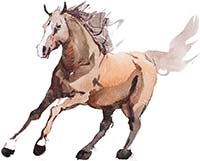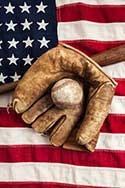Race Horses & Harness Horses ~ Index
Fast horses and baseball formed some of the principal outdoor sports and recreation for Cache Valley residents, in the early days.

As baseball and horse-racing were the principal outdoor sports and recreation for the people in the early as well as the later years of the settlements, much attention was given to producing and training racing stock. Cache Valley was noted for its good racehorses, and horsemen from all parts of the state came here to race.
A fairly good circular half-mile racetrack was constructed on the Church Farm just south of the present Logan Sugar Factory. It was built in 1881 and was the first public circular racecourse in northern Utah and the general public for miles around were well entertained by the races, especially on holidays.

One of the best harness horses at that time was L.C. Lee, a brown stallion owned by Willard Richards, of Mendon. He was one of the first real harness horses produced in the valley and finally went west and made a mark of 2:12. Other good harness horses in those days were Diamond Joe, a sorrel gelding owned by George W. Thatcher, of Logan; Kelly, a brown gelding owned by Jack Edwards, of Logan; Midnight, a black stallion owned by William McAllister of Logan; Monarchist, a black stallion owned by Andrew Bigler of Mendon; Prairie Chief, a brown stallion owned by Riley Kent, of Logan; Rural Chief, a brown stallion owned by Joseph and Hyrum Thatcher of Logan; Grey Chief, owned by Aaron Farr of Logan; Boston, owned by H.J. DeWitt of Logan; Palo Alto, a buckskin gelding owned by John Toombs of Logan; Bridseye, a buckskin mare owned in Richmond; and Nigger Boy owned by Mr. Reed of Ogden. The fastest records of one mile on the track at that time was about 2:21.
Perhaps one of the best and finest matched driving teams ever driven in the valley was owned by Dr. O.C. Ormsby. They were King and Darby; a pair of bays formerly purchased in a wild state by Riley Kent and broken to harness. They could trot together at a 2:50 gait and Dr. Ormsby paid $1050.00 for them. They won many premiums at state and other fairs and attracted the attention of all who saw them. Later, one of the horses died and the other was sold for $1,000.00.
Running Horses
The most outstanding and spectacular performer among the running horses was Jewel, a sorrel mare owned by Moses Thatcher, Sr. She possessed a fine pair of legs but otherwise looked rather stocky and weighed about one-thousand three-hundred pounds. She had an exceptionally fast get-away and was never beaten in a race. Her owners claim that had she been crowded, she could have run the track one-half mile, in forty-nine seconds. This is an exceptionally fast mark and there are few thoroughbred running horses today which can equal it. Pearl, the daughter of Jewel was also fast, but she never had the speed of her dam. She was also owned by Moses Thatcher, Sr. Jewel was imported from Oregon and sold to Moses Thatcher, Sr. for $500.00. Barney, a dark chestnut sorrel was also owned by Moses Thatcher, Sr. and was the first mile horse in the valley.
Other good running horses at that time were Pig, owned by Fred Turner of Logan; Sleepy Tom, owned by the Kent boys; Welch Girl, owned by David Reese, of Benson; Old Joe, owned by David Reese and Aaron Farr; May Queen, owned by W.F. Fisher of Oxford; Brown Legs, owned by Ren Benson, Logan; Danish Girl, owned by J.J. Clark and Coley, owned by the Garr Boys, of Millville. Coley was really the first fast running horse in the valley and was well known for a number of years. The first official running race was conducted on a straight course in the east part of Millville, between Coley, owned by the Garr Boys and a bay horse owned by Joe Bailey of Ogden. The Coley horse won the race.